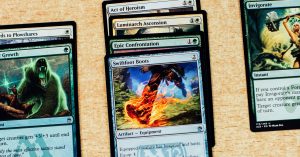Apollo 12 pilot Alan Bean stands on the moon during the second lunar landing in November 1969. A Hasselblad camera is fixed to his chest, and mission commander Pete Conrad is crisply reflected on his helmet’s visor, as Bean holds up a gleaming cylinder filled with lunar dust.
Space-philes can download a high-resolution version of this iconic black-and-white photograph for free from NASA’s website at any time. But if you’re looking for something a bit more luxe and have $3,000 to spend, you can buy a much rarer, vintage silver gelatin print from Sotheby’s. The image, developed in NASA’s photographic laboratories immediately after the mission and autographed by Bean himself, is one of more than 200 prints peddled by the auction house in its first-ever space photos sale, taking place today.
“I love the stuff, people love the stuff,” says Cassandra Hatton, who started up space exploration auctions at Sotheby’s three years ago. “Give the people what they want, you know?”
The market for space memorabilia is growing. Five years ago, Hatton handled a Bonham’s sale that brought in $1 million for just under 300 lots; her most recent in July at Sotheby’s, involving 218 lots, nabbed $5.5 million. The 275-year-old auction house began dealing in space in 1993, when it sold three moon pebbles weighing .0007 ounces—about as much as a raindrop—for $442,500. Hatton resold them last year for nearly twice that. She’s also brokered the $1.8 million sale of the cloth bag Neil Armstrong used to bring back the first lunar samples and a number of spacesuits. “I usually put them on and model them for our catalog,” she says. “Can’t resist.”
The 50th anniversary of the moon landing has further fueled attention on space—particularly photos. In July, Hatton sold a vintage print of Buzz Aldrin climbing down the ladder of the lunar module during the Apollo 11 mission for $40,000, her biggest image sale yet. People bid from all over—the Middle East, Central America, Asia—though buyers from the US, UK, and France dominate. While some have a niche, like 19th century lunar photography, others are less discriminating. “I have one client in particular who is just an obsessive space photography collector and this is all they do,” Hatton says. “They’re just constantly buying.”
NASA offerings in the current sale include official photographs numbered in red or black ink—most taken with Hasselblads by the astronauts themselves and printed directly after the mission on glossy 8×10 Kodak paper for distribution among the press. Since they were frequently handled, finding popular images—like Earthrise from Apollo 8, the first American spacewalk, or Buzz Aldrin’s space selfie—that aren’t scuffed or ripped isn’t easy.
It’s a similar story for the Lunar Orbiter prints on sale. Those were shot by unmanned aircraft between 1966 and 1975 for the purpose of locating potential landing sites. Most depict dirt, craters, and other terrain. More exciting, off-mission shots—like the first view of Earth from the moon—aren’t as common. “Those would usually be printed at the request of a higher-up person in the military or NASA,” Hatton says. “They weren’t printed in large batches.”
The more pristine prints tend to come to Sotheby’s from former government workers in the military and at NASA who received them through their jobs, Hatton says. Years ago, someone found a bunch in a dumpster outside Edwards Air Force Base in California—a “one man’s trash is another man’s treasure kind of deal.” Most in the current sale come from private collector Phillip Kulpa. There are also some intimate, candid snapshots from the estate of NASA’s first senior photographer, Bill Taub, who documented the Project Mercury and Apollo missions and hung his favorite snapshots on the walls of his home.
Oh also: UFO pics. The auction includes several taken in 1976 by “Billy” Eduard Albert Meier, a Swiss ufologist who claimed that aliens began communicating with him at age 5 in 1942. Most famously, one image appeared prominently on a poster in the office of David Duchovny’s character on The X-Files. “A lot of my clients who are interested in space exploration are also kind of interested in the concept of alien life and UFOs,” Hatton says. “It’s not too far off base.” Or, perhaps, one person’s space shuttle is another person’s spaceship.
More Great WIRED Stories
- What we get wrong about “people of color”
- Every tech company wants to be a bank—someday, at least
- How earnest research into gay genetics went wrong
- The Real ID is nearly here, and you can’t fly home without it
- Empathy is tearing us apart
- 👁 A safer way to protect your data; plus, the latest news on AI
- 📱 Torn between the latest phones? Never fear—check out our iPhone buying guide and favorite Android phones



